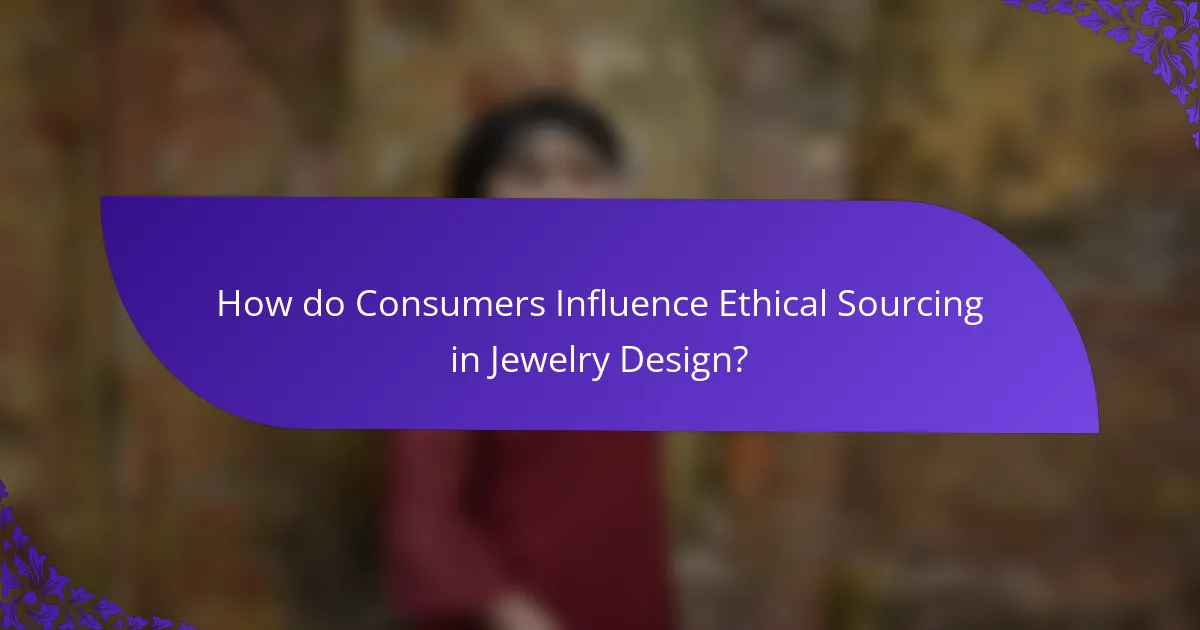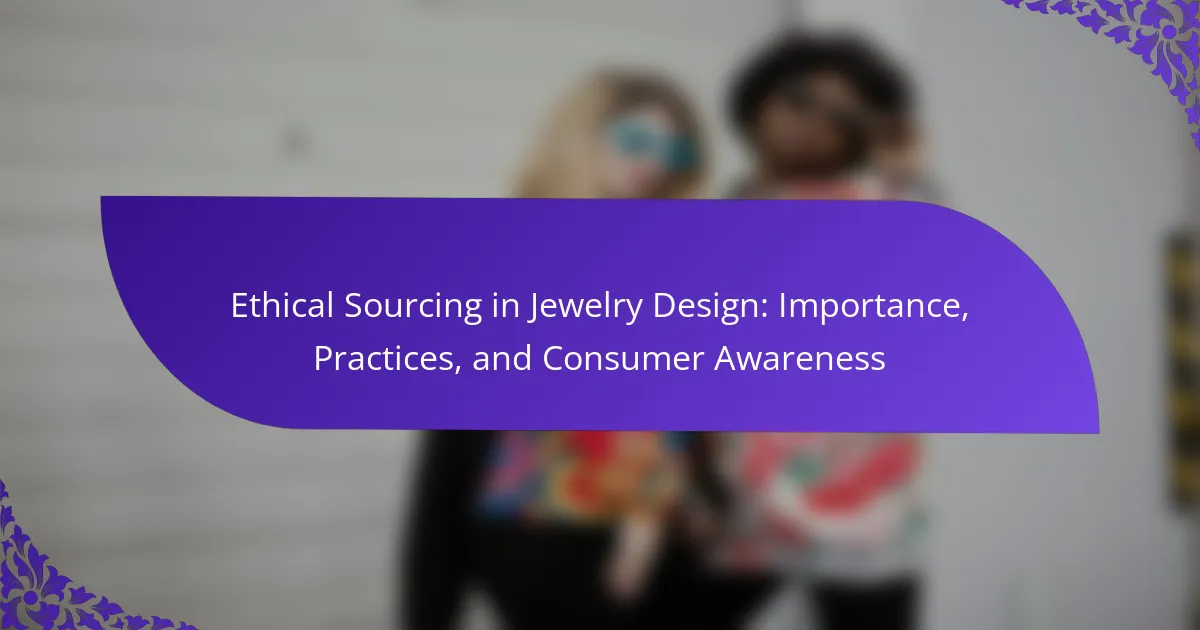Ethical sourcing in jewelry design involves the responsible and sustainable acquisition of materials, ensuring that gemstones and metals are sourced without harming the environment or violating human rights. This practice emphasizes supply chain transparency and aims to prevent worker exploitation while promoting fair labor practices. As consumer demand for sustainability increases, jewelry designers face challenges such as material traceability and compliance with ethical standards. The prevalence of conflict minerals and the higher costs of ethically sourced materials further complicate the landscape, requiring ongoing commitment to responsible sourcing practices. This article explores the importance of ethical sourcing, the practices involved, and the role of consumer awareness in shaping industry standards.

What is Ethical Sourcing in Jewelry Design?
Ethical sourcing in jewelry design refers to the practice of obtaining materials in a responsible and sustainable manner. This includes ensuring that gemstones and metals are mined and produced without causing harm to the environment or violating human rights. Ethical sourcing emphasizes transparency in the supply chain, where the origins of materials are disclosed. It aims to prevent exploitation of workers and promote fair labor practices. According to the Responsible Jewelry Council, ethical sourcing helps to ensure that jewelry production respects both social and environmental standards. This approach is increasingly important to consumers who prioritize sustainability and ethical considerations in their purchasing decisions.
Why is Ethical Sourcing Important in Jewelry Design?
Ethical sourcing is important in jewelry design because it ensures that materials are obtained responsibly. This practice protects human rights and promotes fair labor conditions. It also minimizes environmental impact by reducing pollution and habitat destruction. Ethical sourcing fosters transparency in the supply chain, allowing consumers to make informed choices. In 2021, a survey indicated that 66% of consumers prefer brands that demonstrate ethical practices. By prioritizing ethical sourcing, jewelry designers can enhance their brand reputation and build consumer trust. This approach aligns with the growing demand for sustainable and socially responsible products in the market.
What are the key principles of ethical sourcing?
The key principles of ethical sourcing include transparency, sustainability, and fair labor practices. Transparency ensures that supply chains are open and traceable. This allows consumers to understand the origins of materials used in products. Sustainability focuses on minimizing environmental impact during sourcing. It promotes the use of renewable resources and responsible extraction methods. Fair labor practices guarantee that workers receive fair wages and work in safe conditions. This principle also emphasizes the importance of avoiding child labor and exploitation. Together, these principles aim to create a responsible and ethical supply chain in jewelry design.
How does ethical sourcing impact the jewelry industry?
Ethical sourcing significantly impacts the jewelry industry by promoting sustainable practices and enhancing brand reputation. It addresses concerns related to labor rights, environmental impact, and community welfare. For instance, ethical sourcing ensures that materials are mined without exploitation or harm to workers. According to a 2020 report by the World Gold Council, ethical sourcing can improve consumer trust and loyalty. Furthermore, brands that adopt ethical sourcing often see increased sales, as consumers prefer responsible products. The shift towards ethical practices also encourages transparency in supply chains, fostering accountability among manufacturers.
What are the common practices of Ethical Sourcing in Jewelry Design?
Common practices of ethical sourcing in jewelry design include using conflict-free gemstones and responsibly mined metals. Designers often verify the supply chain to ensure transparency. They may collaborate with certified suppliers who adhere to ethical standards. Sustainable materials, such as recycled metals, are frequently utilized. Fair labor practices are also prioritized, ensuring workers receive fair wages and safe working conditions. Many brands engage in community development initiatives in mining areas. Additionally, certifications like Fair Trade and Responsible Jewelry Council are often sought to validate ethical claims. These practices help minimize environmental impact and promote social responsibility in the jewelry industry.
How do jewelers ensure transparency in sourcing materials?
Jewelers ensure transparency in sourcing materials by implementing strict supply chain practices. They often require documentation proving the origin of gemstones and metals. Many jewelers participate in certification programs like the Responsible Jewelry Council. These programs set standards for ethical sourcing and traceability. Jewelers may also conduct audits of their suppliers to verify compliance. Some use blockchain technology to track the journey of materials from mine to market. This technology provides a secure and immutable record of transactions. By sharing this information with consumers, jewelers build trust and accountability. Transparency in sourcing is increasingly demanded by consumers who value ethical practices.
What certifications exist for ethically sourced materials?
Certifications for ethically sourced materials include Fair Trade, Responsible Jewelry Council (RJC), and the Forest Stewardship Council (FSC). Fair Trade certifies products that meet social, economic, and environmental standards. The Responsible Jewelry Council promotes ethical sourcing and responsible practices within the jewelry supply chain. The Forest Stewardship Council ensures sustainable management of forests, which is crucial for materials like wood and paper. These certifications provide consumers with assurance that materials are sourced responsibly and ethically.

How do Consumers Influence Ethical Sourcing in Jewelry Design?
Consumers influence ethical sourcing in jewelry design by demanding transparency and sustainability. Their preferences shape market trends and compel brands to adopt responsible practices. For instance, a 2020 survey indicated that 66% of consumers are willing to pay more for sustainable products. This trend pressures jewelry designers to source materials ethically. Additionally, social media amplifies consumer voices, allowing them to advocate for ethical practices. Brands that fail to meet these expectations often face backlash, affecting their reputation and sales. Ultimately, consumer choices drive the industry towards more ethical sourcing methods.
What role does consumer awareness play in ethical sourcing?
Consumer awareness is crucial in ethical sourcing as it drives demand for responsibly sourced materials. When consumers are informed, they can make choices that favor brands committed to ethical practices. This awareness leads to increased pressure on companies to adopt transparent supply chains. A study by Nielsen found that 66% of global consumers are willing to pay more for sustainable brands. Companies that prioritize ethical sourcing can enhance their reputation and customer loyalty. In turn, this creates a competitive advantage in the market. Overall, consumer awareness directly influences the ethical sourcing landscape in the jewelry industry.
How can consumers identify ethically sourced jewelry?
Consumers can identify ethically sourced jewelry by checking for certifications and transparency in sourcing. Look for certifications like Fair Trade or Responsible Jewelry Council. These certifications ensure adherence to ethical practices. Additionally, reputable brands often provide information about their supply chain. This includes details on where materials are sourced and how workers are treated. Researching the brand’s policies on sustainability and labor rights can also be helpful. Consumers should seek jewelers who prioritize ethical sourcing in their marketing. Engaging with brands on social media can provide insights into their practices. Overall, informed choices can lead to the purchase of ethically sourced jewelry.
What questions should consumers ask about sourcing practices?
Consumers should ask about the origin of materials used in jewelry. They should inquire whether the materials are sourced from conflict-free zones. Questions about the environmental impact of sourcing practices are also important. Consumers should ask if the sourcing practices adhere to fair labor standards. It’s essential to know if the suppliers provide transparency in their sourcing chain. Additionally, consumers should inquire about certifications related to ethical sourcing. Questions about the brand’s commitment to sustainable practices should also be considered. Finally, consumers should ask how the brand ensures traceability of its materials.
Why is consumer demand for ethically sourced jewelry increasing?
Consumer demand for ethically sourced jewelry is increasing due to heightened awareness of social and environmental issues. Consumers are increasingly concerned about the origins of materials used in jewelry. Ethical sourcing ensures that materials are obtained without exploitation or harm to communities and the environment. Reports indicate that 66% of global consumers are willing to pay more for sustainable brands. This trend is fueled by a younger demographic prioritizing ethical consumption. Additionally, brands that promote transparency in their supply chains attract more customers. The rise of social media amplifies consumer voices advocating for ethical practices. Consequently, the demand for ethically sourced jewelry is on the rise.
How do social media and online platforms affect consumer choices?
Social media and online platforms significantly influence consumer choices by shaping perceptions and providing information. They serve as vital channels for brand exposure and consumer engagement. Platforms like Instagram and Facebook enable brands to showcase their products visually. This visual appeal can enhance consumer interest and drive purchasing decisions. User-generated content, such as reviews and testimonials, also plays a crucial role. Consumers often trust peer recommendations over traditional advertising. According to a Nielsen report, 92% of consumers trust recommendations from friends and family. Additionally, social media allows for real-time feedback and interactions, fostering a sense of community around brands. This community engagement can lead to increased brand loyalty and repeat purchases. Overall, social media and online platforms are powerful tools that shape consumer behavior and preferences.
What trends are emerging in consumer preferences for ethical jewelry?
Consumers are increasingly prioritizing sustainability and transparency in ethical jewelry. There is a growing demand for materials sourced from responsible mines. Many consumers prefer lab-grown gemstones over mined alternatives. This shift reflects concerns about environmental impact and labor practices. Additionally, consumers are seeking brands that provide detailed information about sourcing practices. The rise of social media has amplified awareness of ethical issues. Many consumers are influenced by peer recommendations and brand storytelling. Research indicates that 70% of millennials are willing to pay more for ethical products. This trend highlights a significant cultural shift towards conscious consumerism in the jewelry market.

What Challenges Exist in Ethical Sourcing for Jewelry Designers?
Jewelry designers face several challenges in ethical sourcing. One major challenge is the traceability of materials. Many gemstones and metals come from complex supply chains, making it difficult to verify their origin. Additionally, ensuring compliance with ethical standards can be costly and time-consuming. Designers often lack access to reliable information about their suppliers’ practices.
Another challenge is the prevalence of conflict minerals. These materials can finance violence and human rights abuses in mining regions. Designers must navigate regulations like the Dodd-Frank Act, which aims to prevent the use of conflict minerals.
Consumer demand for transparency adds pressure on designers to provide detailed sourcing information. However, many consumers lack awareness of the complexities involved in ethical sourcing. This disconnect can lead to skepticism about claims of ethical practices.
Finally, the higher costs associated with ethically sourced materials can limit market competitiveness. Designers may struggle to balance ethical considerations with pricing pressures. These challenges require ongoing commitment and innovation in sourcing practices.
What are the barriers to implementing ethical sourcing practices?
Barriers to implementing ethical sourcing practices include high costs, lack of transparency, and limited supplier options. High costs arise from sourcing materials that meet ethical standards. Many suppliers do not provide clear information about their sourcing practices. This lack of transparency makes it difficult for brands to verify compliance. Limited supplier options can restrict access to ethically sourced materials. Additionally, consumer demand for lower prices often conflicts with ethical sourcing initiatives. These barriers hinder the adoption of ethical practices in the jewelry industry.
How do cost considerations affect ethical sourcing?
Cost considerations significantly impact ethical sourcing by influencing decisions on supplier selection and material procurement. Companies often prioritize lower costs to maximize profit margins. This can lead to sourcing from suppliers with questionable ethical practices. For instance, suppliers may exploit labor or engage in environmentally harmful practices to reduce costs. According to a study by the Ethical Trading Initiative, 60% of businesses reported cost pressures as a barrier to implementing ethical sourcing standards. This indicates a direct correlation between cost considerations and the compromise of ethical sourcing efforts. Therefore, balancing cost and ethics is crucial for sustainable practices in jewelry design.
What challenges do designers face in sourcing sustainably?
Designers face numerous challenges in sourcing sustainably. Limited availability of sustainable materials restricts choices for designers. High costs associated with sustainable materials can impact budget constraints. Supply chain transparency is often lacking, making it difficult to verify sourcing practices. Designers also encounter a lack of standardized certifications for sustainable materials. Consumer demand for sustainability may not always align with market trends. Additionally, the complexity of sourcing from multiple suppliers complicates the process. These challenges can hinder the implementation of sustainable practices in jewelry design.
How can jewelry designers overcome these challenges?
Jewelry designers can overcome challenges in ethical sourcing by implementing transparent supply chains. They should establish relationships with certified suppliers to ensure responsible sourcing of materials. Utilizing recycled metals can reduce environmental impact and reliance on mined resources. Designers can also adopt traceability technologies, such as blockchain, to verify the origin of materials. Engaging in fair trade practices ensures that artisans receive fair compensation. Educating consumers about the importance of ethical sourcing can enhance brand loyalty. According to a 2021 survey by the Ethical Trade Initiative, 76% of consumers prefer brands that prioritize ethical practices. This consumer demand can drive jewelry designers to adopt more sustainable approaches.
What best practices can be adopted for successful ethical sourcing?
Successful ethical sourcing involves implementing transparent supply chains. Companies should conduct thorough audits of suppliers to ensure compliance with ethical standards. Establishing long-term relationships with suppliers fosters accountability and trust. Training programs for suppliers on ethical practices can enhance awareness and adherence. Utilizing certifications from recognized organizations can validate ethical sourcing claims. Regularly engaging with stakeholders, including local communities, ensures their needs and rights are respected. Companies should also adopt traceability systems to track materials from origin to final product. These practices collectively promote sustainability and social responsibility in the jewelry industry.
What practical steps can consumers take to support ethical sourcing?
Consumers can support ethical sourcing by researching brands and their sourcing practices. They should look for certifications like Fair Trade or Responsible Jewelry Council. Purchasing from local artisans can also promote ethical practices. Supporting brands that prioritize transparency in their supply chains is essential. Consumers can advocate for ethical sourcing by engaging in discussions and raising awareness. Sharing information on social media can amplify the message. Additionally, consumers can choose to buy less and invest in high-quality, ethically sourced pieces. These actions collectively encourage brands to adopt ethical sourcing practices.
Ethical sourcing in jewelry design refers to the responsible and sustainable acquisition of materials, ensuring that gemstones and metals are sourced without harming the environment or violating human rights. The article outlines the significance of ethical sourcing, key principles such as transparency and fair labor practices, and its impact on the jewelry industry. It also discusses common practices among designers, the role of consumer awareness in influencing ethical sourcing, and the challenges faced in implementing these practices. Additionally, the article highlights emerging consumer preferences for ethically sourced jewelry and practical steps consumers can take to support ethical sourcing initiatives.


